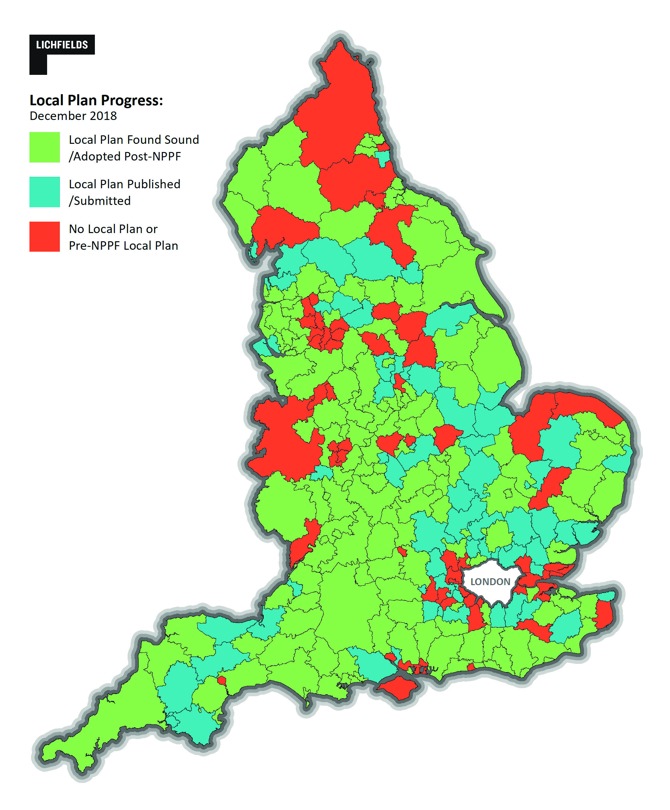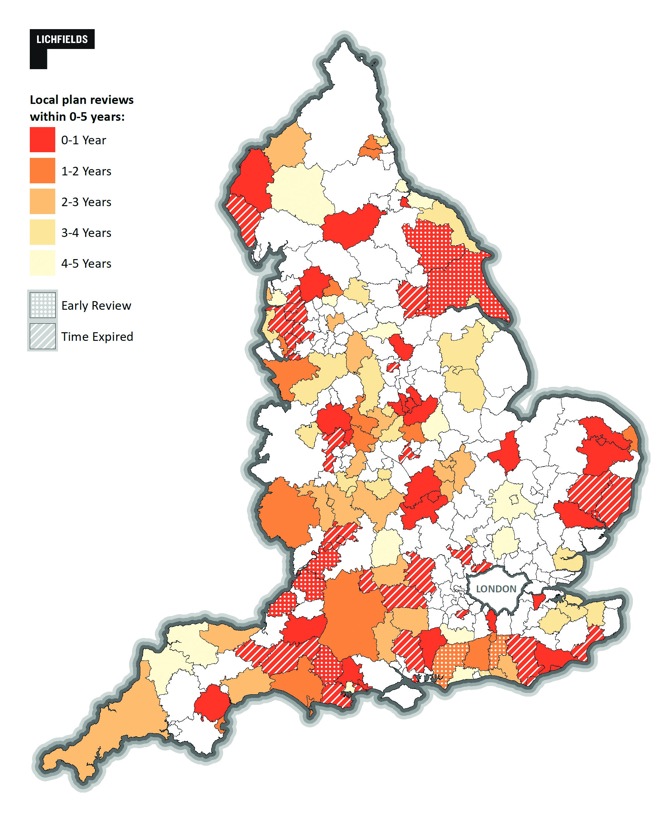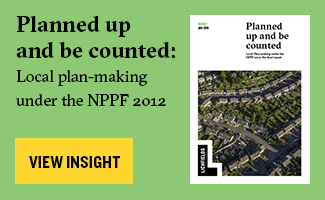Lichfields is currently monitoring the draft London Plan Examination in Public (EiP), which is scheduled to last until May 2019, and will report on relevant updates as part of a blog series. The third blog of the series focuses on the hearing session for draft policies H5-H8 on Affordable Housing, which took place on 26 February 2019.
The Big Picture is the target for all housing being increased from 45,000 dwellings per annum up to 65,000 dwellings per annum in the draft new London Plan in the face of a 13% undershoot against even the previous target according to GLA (or 31% according to MHCLG). Accordingly, the new target could be missed by as much as 40%-50% if delivery solutions do not change. Moreover, the Deputy Mayor for Housing, James Murray, has said that 80% of new homes in London are affordable to only 8% of the population.
In terms of tenure, it was suggested at the EiP hearing session that market housing delivery has recently been running at over 30% above target, whilst affordable housing is sliding even further behind. And the draft new London Plan seeks to deliver only 33,000 affordable homes per annum against its SHMA-identified target of 43,500 homes per annum.
The more detailed ‘small picture’ includes the differences in delivery across London Boroughs, following former Mayor Boris Johnson’s earlier local relaxations against centralised targets. At the EiP session, it was said that 19 of the 32 London Boroughs delivered no social rent housing at all last year – and that, from 2010 to 2017, the average delivery of all types of affordable housing was only 18% of all housing completions, with no borough averaging up to the mayoral target of 35%. The subtlety in these figures is the recent rise in the proportion of delivery of intermediate products rather than social rent. This is in part due to the recent first tranche of Government grants with, for example, Waltham Forest described as achieving 49% affordable housing delivery but with only 1% social rent.
The Home Builders Federation (HBF) indicated that the reality of negotiations is that other policy priorities, including through s106 contributions, such as space standards, cycle provisions, CIL and affordable workspaces, come before affordable housing provision – with the resulting affordable housing percentage outcome being established after an appraisal has taken into account of all these factors (‘in accordance with other policies of the plan’).
With the strategic affordable housing target proposed at 50%, the acknowledged reality is that this will generally be ‘dumbed down’ to 35%, as arising from the new threshold approach to affordable housing; however, the GLA said that the threshold approach is already proving successful by dragging those schemes proposing truly lower affordable housing percentages back up to 35% just to avoid full viability assessment and thereby saving precious months.
But Sian Berry (Green Party, London Assembly Member) noted that this approach effectively reduces the strategic affordable housing target down to 35%, with those schemes delivering lower levels balanced out by others, such as those delivered by Registered Providers and which provide higher levels of affordable housing (typically 70-80%). The outcome thereby appears to be that the strategic target could never be met in practice and that the Plan would fail in its duty. She therefore argued for a steady increase in the 35% threshold through proposed 5-yearly reviews to increase pressure – all with the impact of embedding lower land values generally.
The GLA pleaded that central government funding approaches have changed since the first draft Plan (November 2017), with the lifting of the local authorities’ borrowing cap and the release of direct housing funding, and that the outcome of these changes is not yet clear, particularly with the relatively low level of subsidy per delivered unit– which is more useful in supporting intermediate housing rather than social rent. It also noted that grant negotiations with central government are limited to only one week of discussions but that the consequences are long term, meaning that revisions from 35% for the threshold target every 5 years is in the nature of star-gazing in the face of general elections, Brexit, etc., even though the GLA is required to produce a sound and deliverable Plan.
So, what are the pressures that affect affordable housing delivery in London?
- The current government is reluctantly engaging in social housing delivery, both through grant and allowing local authorities to borrow again, after its demise in the Thatcher era – although limiting the types of tenure by inherent support for intermediate products. Hence the arrival of London Living Rent as a new intermediate product (see Lichfields’ Insight Focus for more details). National political changes (i.e. not controlled by the Mayor) mean continued uncertainty of this means of bridging the gap between what is needed and what can be delivered – up or down. However, central government still also pressurises the Mayor to review the Plan, suggesting even higher overall targets (as per Standard Method figures).
- London Boroughs have different political agendas and differing approaches to delivery, including within negotiations with developers. It is often a matter of balance between quantum delivered (good news) and a revised tenure mix (mostly bad news) away from the historic 70/30 or 60/40. Furthermore, there is the possible need to introduce a tariff-based contribution for affordable housing in relation to the small sites needed to deliver roughly 40% of London’s overall housing target.
- Tenants groups rightly complain that we are never going to meet real need with current or even proposed policies, noting that developers aim to maximise profits by going along with the rules and maximising the value of affordable housing in each case. However, central government is said to need to invest four times as much into affordable housing in London to allow Councils and Registered Providers to step up delivery to the plate and allow the London Plan to meet either the objectively assessed need or even the (lower) current target.
- Furthermore, developers try to maximise profits and turn sites around as quickly as possible, delivering just as much affordable housing as is required and no more. This builds in the lower 35% target as one to reach to avoid time-wasting or to avoid if nowhere near achievable.
- For public land owners, the higher 50% affordable housing threshold target is criticised as undermining a revenue stream that can fund improved services provision – why should NHS or TfL money be used for affordable housing in a particular local authority area? The high threshold will encourage public bodies to consider commercial alternatives rather than housing delivery. There is also the ongoing question as to whether those bodies with a portfolio approach to such delivery levels across a ‘bundle’ of their sites would manipulate this to get lower levels of affordable housing in higher value areas yet still meet their target.
- For formerly-industrial land, the higher 50% affordable housing threshold also reduces the propensity to go for residential or residential-led mixed-use development – undermining yet another source for brownfield housing delivery.
So, the EiP Panel needs to address and resolve these pressures as far as possible, deciding whether the GLA is right in adopting what it often described as ‘challenging yet deliverable’ policies to paper over the cracks. To agree a target whilst not meeting identified needs. To hope that political pressure on central government will continue the recent increases in support for Registered Providers and for Councils.
The urgent need for an updated London Plan will probably override indecision at this stage – an adopted Plan is better than no Plan – but that will lead to numerous unknowns. Other than that, it is clear that the full need for affordable housing delivery to meet London requirements is beyond the control of the London Plan.
Lichfields will publish further analysis on the draft London Plan Examination in Public in due course. Click here to subscribe for updates.
This blog has been written in general terms and cannot be relied on to cover specific situations. We recommend that you obtain professional advice before acting or refrain from acting on any of the contents of this blog. Lichfields accepts no duty of care or liability for any loss occasioned to any person acting or refraining from acting as a result of any material in this blog. © Nathaniel Lichfield & Partners Ltd 2019, trading as Lichfields. All Rights Reserved. Registered in England, no 2778116. 14 Regent’s Wharf, All Saints Street, London N1 9RL. Designed by Lichfields 2019









